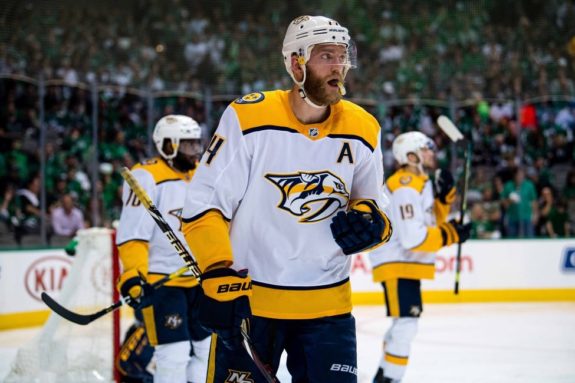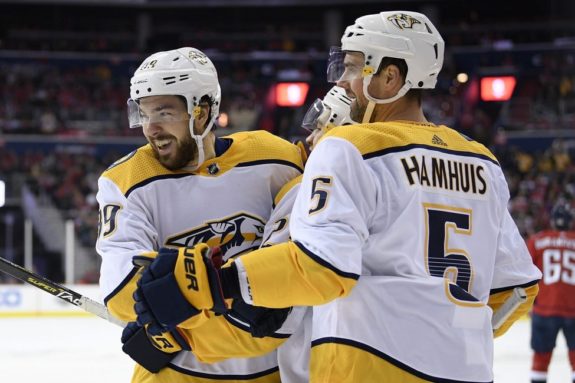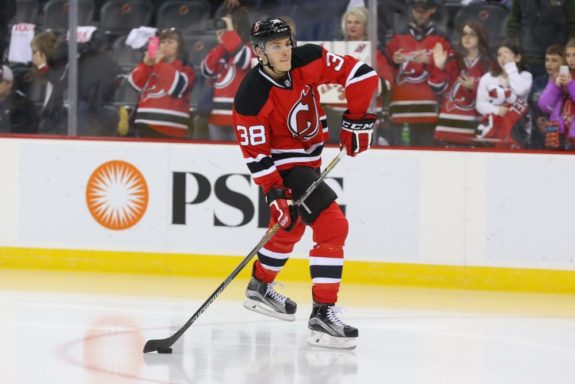The Nashville Predators are scoring at a prolific rate. In fact, after Tuesday night’s win against the Vegas Golden Knights, the Predators have scored 28 goals through their first six games of the season, the most in franchise history. The Predators have scored at least four goals in five of those six contests and sit a top of the league with 4.67 goals per-game.
Due to the comebacks that the Predators have required, this never-before-seen offence has come in handy. Two of Nashville’s four wins have come when trailing after two periods, something the Predators were able to do just six times all of last season. A large chunk of the Predators’ 28 goals have come in the third period, scoring 16 times in the final frame of regulation alone.
However, just because the Predators are filling the opposition’s net on a nightly basis doesn’t mean all their wins are via blow-outs. Nashville’s scoring a bunch, but they’re also giving up plenty.
Defense Optional?
Through their first six games, the Predators have a goals-against average (GAA) of 3.83, which is fifth-worst in the league. The only teams with a higher GAA are the Montreal Canadiens, Minnesota Wild, New Jersey Devils and Los Angeles Kings, teams that most would not consider playoff contenders.
Related: Can Predators’ Juuse Saros Fill Pekka Rinne’s Pads?
Just as the Predators have set a franchise record for the most goals scored through their first six games of a season, their 23 goals against is also the most they have given up. Their high goals against to this point nearly doubles their total from last season through six games, when they surrendered just 12 goals.

The defense as a whole hasn’t exactly been up-to-par. The Predators have given up 15 goals at five-on-five, while their penalty kill sits at 25th in the league, killing off 72.2 percent of the power plays they face.
Pointing the finger to where the breakdown is coming from isn’t as simple as shot volume. The Predators are giving up an average of 31 shots per-game, which is the 13th fewest in the league.
Head coach Peter Laviolette believes it’s not just one specific problem on defense, but rather it’s the mistakes they are making as a team where the most damage is being done.
“One game it was the forecheck,” Laviolette told Paul Skrbina of The Tennessean. “The game after that it was about turning it over in the offensive zone at inopportune times. I don’t know if it’s so much about straight d-zone coverage as it is about self-inflicted wounds.” (from ‘Predators good to goal so far, but there could be a hole in the defense, The Tennessean, 10/12/2019).
Who’s on Third (Pairing)?
Head coaches will always avoid calling players out by name when they make costly mistakes or if they aren’t doing a good enough job, sometimes it happens, but it’s very rare. So, it’s no surprise that the play of the third defensive paring, one of the major problems, hasn’t been addressed.
Often rotating and never seemingly set, the partnerships of Dan Hamhuis and Yannick Weber or Matt Irwin and Weber have not been a strong facet of the Predators’ game. The three defensemen have combined for a minus-eight rating so far this season.

According to Natural Stat Trick, out of those pairings listed the most common is Hamhuis and Weber, logging just over 39 minutes of ice time together. As a pairing, they have been on the ice for just one goal for and four against when at five-on-five.
However, it doesn’t get better when juggling the pairing and switching Hamhuis for Irwin. Among defensive partners with at least 15 minutes of five-on-five action, Weber and Irwin have combined for the third-worst Corsi for percentage in the league, sitting at 22.58.
The top-two defensive pairings have shouldered the load for the past few seasons, it’s to be expected, as minutes are rarely divided equally among every line. This season, Roman Josi and Ryan Ellis have played the most minutes together five-on-five, logging 93:37 of time-on-ice (TOI), but only barely, as Mattias Ekholm and Dante Fabbro are less than 40 seconds behind the top-pairing’s total.
However, the third pairing of Hamhuis and Weber aren’t even close to those minutes, registering less than half the time at 39:03. But, even with how little they’re on the ice, in comparison, it still seems like a risk every time anyone other than Josi, Ellis, Ekholm or Fabbro is on the ice. It will be a major problem later in the season if the third pairing cannot be relied upon to absorb some of the punishing minutes that rack up during an 82-game season.
Time for an Early Season Call-up
Do not hit the panic button, all is not lost. The Predators have plenty of talent stashed away in their American Hockey League team, the Milwaukee Admirals, that is capable of righting this ship.
Steven Santini has over 100 games of NHL experience and was also one of the very last cuts made by the Predators coming out of training camp. He was never going to be an exact replacement for P.K. Subban, the player he was traded for, but at this point, it may be worth giving Santini a shot to help fill the void left now that the former Norris Trophy-winning defenseman is playing in the Eastern Conference.

Santini has been a steady presence while playing for the Admirals. The Mahapac, NY native has already recorded a point in his first three AHL games this season and is a plus-one.
Jarred Tinordi is another player who just missed making the Predators’ roster out of training camp and could be an option for the Predators to shake-up their defensive woes. Laviolette was really impressed with the 6-foot-6 blueliner’s showing in the preseason, meaning a call-up may have always been on the horizon this season.
“Jared’s camp was really strong, stronger than last year,” Laviolette said of Tinordi to Brooks Bratten via the Predators’ website. “He’s a great player, and we wanted to really continue to see him playing games, but we do see him as a part of the season. Right now, it’s in Milwaukee, but his size and his toughness bring elements that we could be looking for.”

Well, the Predators could be looking for those “elements” sooner rather than later, especially after surrendering close to four goals a game this season. Six games is a small sample size, so there’s no reason to overreact, but the allowing the problem to continue longer than needed is a dangerous game to play.